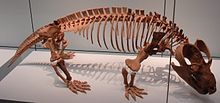Cynodont
| Cynodonts Temporal range: Late Permian-Holocene, 260–0 Ma |
|
|---|---|
 |
|
| Fossil of Chiniquodon in the Staatliches Museum für Naturkunde Stuttgart | |
| Scientific classification | |
| Kingdom: | Animalia |
| Phylum: | Chordata |
| Order: | Therapsida |
| Clade: | Eutheriodontia |
| Suborder: |
Cynodontia Owen, 1861 |
| Families | |
|
See text |
|
See text
The cynodonts ("dog teeth"), in the clade Cynodontia, are therapsids that first appeared in the Late Permian (approximately 260 Ma). The group includes modern mammals (including humans) as well as their extinct ancestors and close relatives. Nonmammalian cynodonts spread throughout southern Gondwana and are represented by fossils from South America, Africa, India, and Antarctica. In the northern continents, fossils have been found in eastern North America as well as in Belgium and northwestern France. Cynodontia is one of the most diverse groups of therapsids.
Richard Owen named Cynodontia in 1861, which he assigned to Anomodontia as a family.Robert Broom (1913) reranked Cynodonia as an infraorder, since retained by others, including Colbert and Kitching (1977), Carroll (1988), Gauthier et al. (1989), and Rubidge and Cristian Sidor (2001). Olson (1966) assigned Cynodontia to Theriodonta, Colbert and Kitching (1977) to Theriodontia, and Rubridge and Sidor (2001) to Eutheriodontia. William King Gregory (1910), Broom (1913), Carroll (1988), Gauthier et al. (1989), Hopson and Kitching (2001) and Botha et al. (2007) all considered Cynodontia as belonging to Therapsida. Botha et al. (2007) seems to have followed Owen (1861), but without specifying taxonomic rank.
Together with the extinct gorgonopsians and the therocephalians, the cynodonts themselves are part of a group of therapsids called theriodonts.
...
Wikipedia
